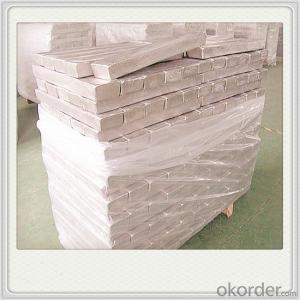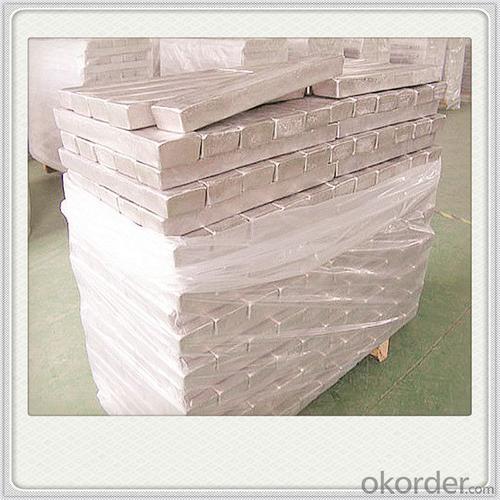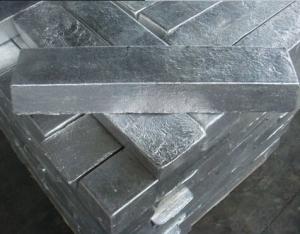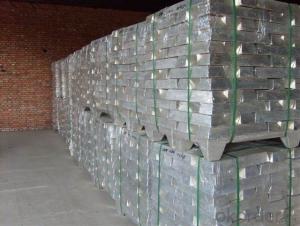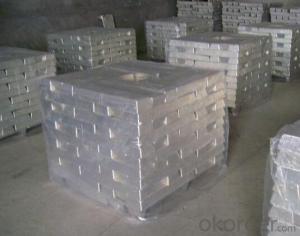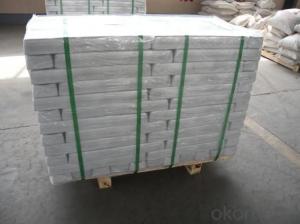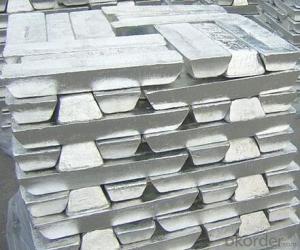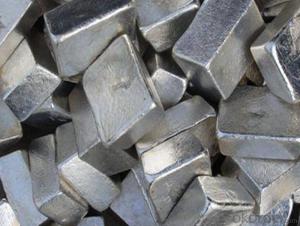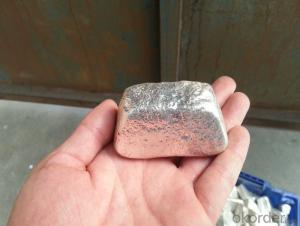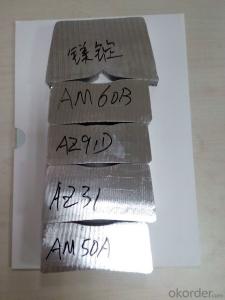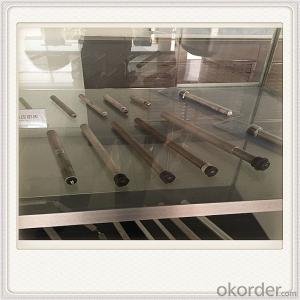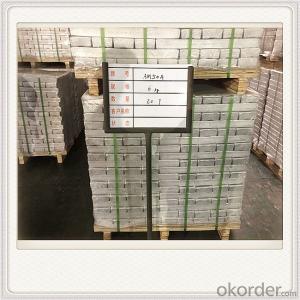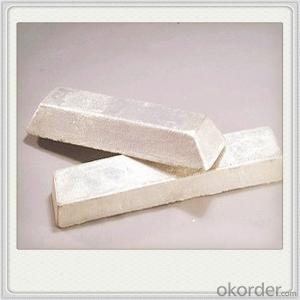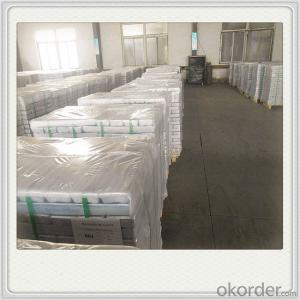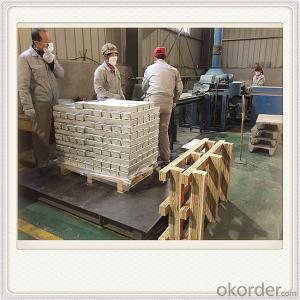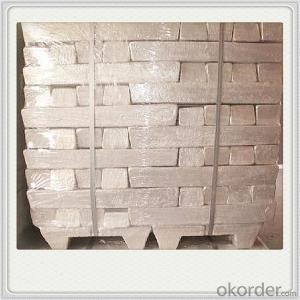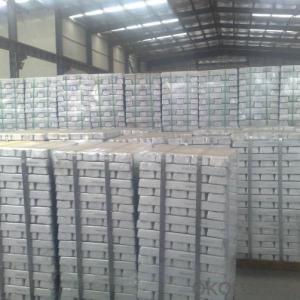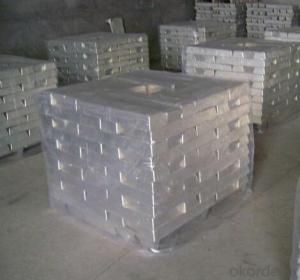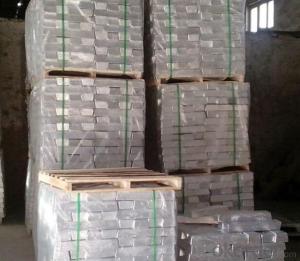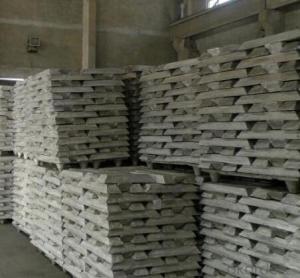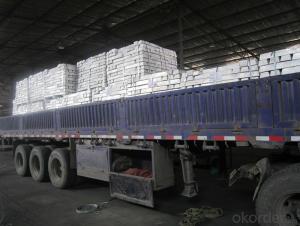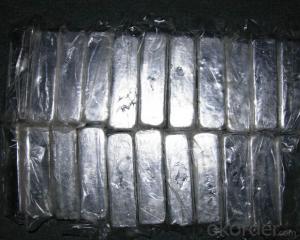Magnesium Alloy Ingot Plate Good Quality Magnesium Metal Ingot
- Loading Port:
- Tianjin
- Payment Terms:
- TT OR LC
- Min Order Qty:
- 5 m.t.
- Supply Capability:
- 20000 m.t./month
OKorder Service Pledge
OKorder Financial Service
You Might Also Like
1. Specification:The Mg Metal is a fairly strong, silvery-white, light-weight metal.
Form: ingot
ingot: (8 ± 0.5) kg / ingot
Specifications: (50-55)cm×(11.5-13.5)cm×(7-7.5)cm
2. Application:
1. The high temperature at which magnesium burns makes it a useful tool for starting emergency fires during outdoor recreation. Other related uses include flashlight photography, flares, pyrotechnics and fireworks sparklers.
2. To photoengrave plates in the printing industry.
3. In the form of turnings or ribbons, to prepare Grignard reagents, which are useful in organic synthesis.
4. As an additive agent in conventional propellants and the production of nodular graphite in cast iron.
5. As a reducing agent for the production of uranium and other metals from their salts.
6. As a sacrificial (galvanic) anode to protect underground tanks, pipelines, buried structures, and water heaters.
3. Mg Alloys Metal (Ingot)
Mg ingot | |||||||||||
Brand | chemical composition | ||||||||||
Mg | |||||||||||
Fe | Si | Ni | Cu | Al | Cl | Mn | Ti | others | |||
Mg99.98 | 99.98 | 0.002 | 0.003 | 0.002 | 0.0005 | 0.004 | -- | 0.002 | -- | 0.02 | |
Mg99.96 | 99.96 | 0.004 | 0.004 | 0.0002 | 0.002 | 0.006 | 0.003 | 0.003 | -- | 0.04 | |
Mg99.95 | 99.95 | 0.004 | 0.005 | 0.0007 | 0.003 | 0.006 | 0.003 | 0.01 | -- | 0.05 | |
Mg99.90 | 99.90 | 0.04 | 0.01 | 0.001 | 0.004 | 0.02 | 0.005 | 0.03 | -- | 0.10 | |
Mg99.80 | 99.80 | 0.05 | 0.03 | 0.002 | 0.02 | 0.05 | 0.005 | 0.06 | -- | 0.20 | |
4. Advantages:
Good Quality ............... The most important factor we care.
Competitive Price ........ For our mutual benefit.
Prompt delivery ........... Abundant production ability, storage ability and manpower.
Excellent Service ......... Customer always first.
Now our main markets in Asia and Europe, to the future we will set up sales network in more than 200 countries around the world.
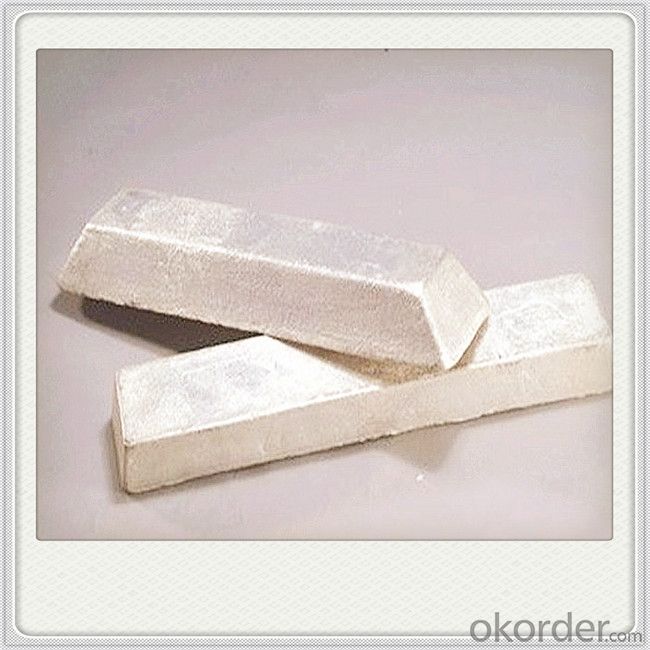
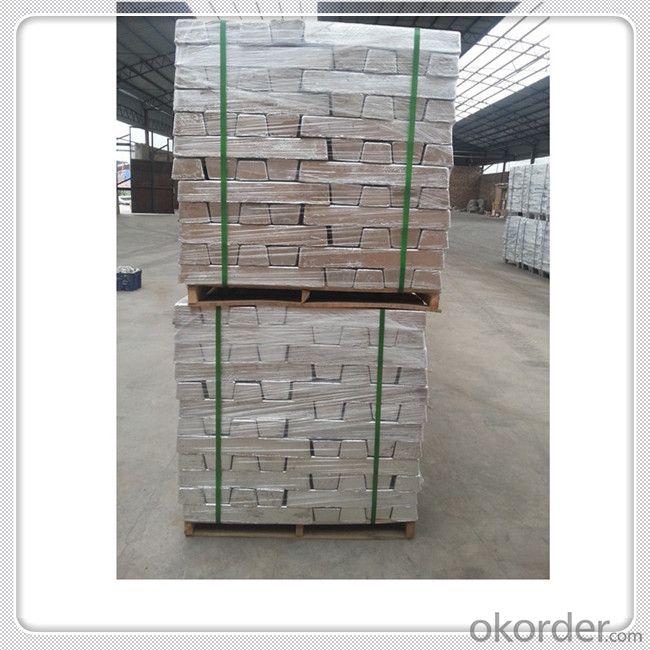
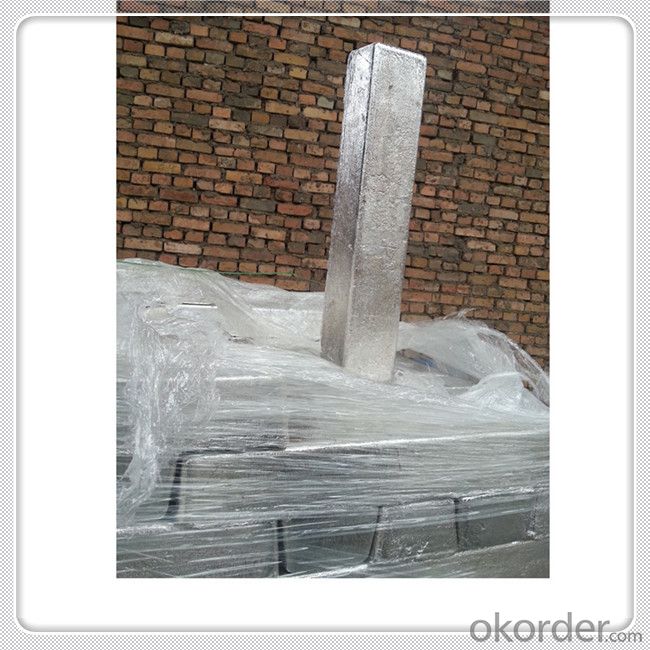
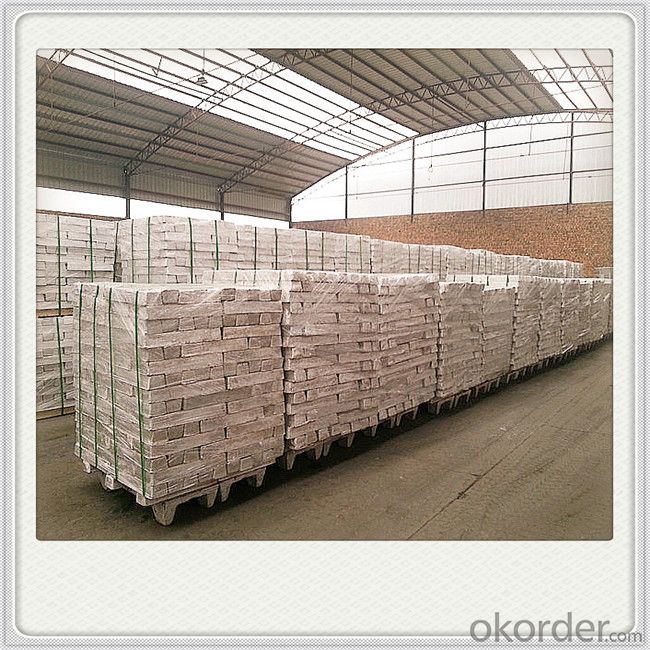
What is Magnesium Alloys?
Magnesium alloys are mixtures of magnesium with other metals (called an alloy), often aluminum, zinc, manganese, silicon, copper, rare earths and zirconium. Magnesium is the lightest structural metal. Magnesium alloys have a hexagonal lattice structure, which affects the fundamental properties of these alloys. Plastic deformation of the hexagonal lattice is more complicated than in cubic latticed metals like aluminium, copper and steel; therefore, magnesium alloys are typically used as cast alloys, but research of wrought alloys has been more extensive since 2003. Cast magnesium alloys are used for many components of modern automobiles, and magnesium block engines have been used in some high-performance vehicles; die-cast magnesium is also used for camera bodies and components in lenses.
Practically, all the commercial magnesium alloys manufactured in the United States contain aluminum (3 to 13 percent) and manganese (0.1 to 0.4 percent). Many also contain zinc (0.5 to 3 percent) and some are hardenable by heat treatment. All the alloys may be used for more than one product form, but alloys AZ63 and AZ92 are most used for sand castings, AZ91 for die castings, and AZ92 generally employed for permanent mold castings (while AZ63 and A10 are sometimes also used in the latter application as well). For forgings, AZ61 is most used, and here alloy M1 is employed where low strength is required and AZ80 for highest strength. For extrusions, a wide range of shapes, bars, and tubes are made from M1 alloy where low strength suffices or where welding to M1 castings is planned. Alloys AZ31, AZ61 and AZ80 are employed for extrusions in the order named, where increase in strength justifies their increased relative costs.
5.FAQ
We have organized several common questions for our clients,may help you sincerely:
①How about your company?
CNBM, The Fortune 500. A world class manufacturer & supplier of magnesium alloys ingots plates&sheets, magnesium alloy bars, Magnesium alloy slabs,magnesium alloy wires,magnesium alloy tubes and etc.. bases in China.
②How to guarantee the quality of the products?
We have established the international advanced quality management system,every link from raw material to final product we have strict quality test;
We would like to offer free samples for your inspect and check.
We have advanced manufactured equipments,such as hot rolling equipment. We resolutely put an end to unqualified products flowing into the market. At the same time, we will provide necessary follow-up service assurance.
③What is your main markets?
Our main markets are from Europ, America and Aisa. Such as Germany,Czech, Poland, England, Canada, Korea, Turkey etc.
- Q: Causes of high manganese content in magnesium ingot
- Potassium Permanganate heat decomposition of potassium manganate, manganese dioxide and oxygen, and the quality of solid oxygen generating surplus.
- Q: What is the black powder on the surface of magnesium ingot AM50A?
- The first is the alloy composition is different: AM50, AM60 is Mg-Al-Mn series, AZ91D is Mg-Al-Zn series.
- Q: What are the surface defects of magnesium alloy rolling?
- General magnesium alloys will not be rolled, so that the rolled products are easy to oxidize and not conducive to preservation
- Q: What harm does magnesium alloy have to human body?
- The main element of magnesium aluminum alloy and AZ91D is magnesium. As long as it is not dust (flammable or explosive), direct contact with magnesium ingot is harmless
- Q: What are the generally feasible surface treatment methods for magnesium alloy die castings?
- 1. chromate passivation method, which is the most widely used and the most important method in industry. The so-called chromate passivation solution is metal with chromic acid, chromate or dichromate as a major component of the film on the metal surface to form a compound composed of trivalent chromium and hexavalent chromium and six metal itself, this film has protective passivation metal corrosion inhibition for. The specific passivation process is to dip the magnesium ingot which is intended to be passivated into the passivation solution. At this time, the surface metal is oxidized by the solution, forming metal ions into the solution. Since the solution is acidic, the following reactions occur: 3Mg ten, 2HN03 = 4Mg0, ten H20, ten 2N02. anodic oxidation is a surface treatment method to increase the thickness of base metal oxide film by electrolytic reaction and to improve the film properties. The film has excellent corrosion resistance and abrasion resistance.
- Q: Why the cost of ferrosilicon production will lead to a rebound in the price of magnesium ingot?
- 75# ferrosilicon in pidgeonmagnesiumprocess often used in high temperature smelting process of magnesium metal, will be replaced from CaO.MgO mg, each ton of magnesium will consume 1.2 tons of ferrosilicon, plays a big role in magnesium production.
- Q: The industrial application of magnesium and the main title and technical difficulty of producing magnesium products with magnesium chloride as raw material
- The chemical property of magnesium is active, in the metallurgical industry by using, steel and non-ferrous metal casting, with magnesium as desulfurization agent, cleaning agent, as reducing agent in the production of rare metal. In the chemical industry, magnesium can be used as a dehydrating agent of organic compounds or directly with organic compounds and preparation of magnesium powder. In recent years, in the use of magnesium powder spray, coating, anticorrosion industry is more and more big, the amount of silicon and polysilicon and powder metallurgy die casting is also great.
- Q: What are the differences between aluminium magnesium alloy, aluminum alloy and plastic steel?
- In the fireworks production process plays a very important role in reducing agents, but also as a white light agent and lighting agentMagnesium alloy is magnesium ingots and aluminum ingots in protective gas melted into. For a long time about the structure of Al Mg alloy with two kinds of argument. One theory is that magnesium alloy is a simple physical mixture; another is magnesium alloy changes inside the crystal structure, is not a simple physical mixture.
- Q: Will the enterprises that produce sponge titanium use magnesium ingots?
- Can be used, or can not be, according to process methods and the production of sponge too, one way is to use magnesium reduction method
- Q: What is magnesium aluminum alloy and what is its use?
- Magnesium alloy is magnesium ingots and aluminum ingots in protective gas melted into. For a long time about the structure of Al Mg alloy with two kinds of argument. One theory is that magnesium alloy is a simple physical mixture; another is magnesium alloy changes inside the crystal structure, is not a simple physical mixture.
Send your message to us
Magnesium Alloy Ingot Plate Good Quality Magnesium Metal Ingot
- Loading Port:
- Tianjin
- Payment Terms:
- TT OR LC
- Min Order Qty:
- 5 m.t.
- Supply Capability:
- 20000 m.t./month
OKorder Service Pledge
OKorder Financial Service
Similar products
Hot products
Hot Searches
Related keywords
